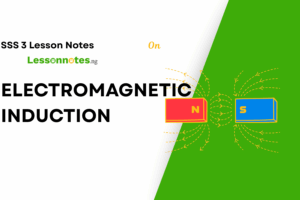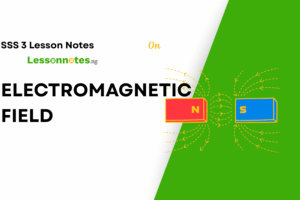Nucleus & Radioactivity, Nuclear Reaction. SS3 Physics Lesson Note
Download Lesson NoteTopic: Nucleus & Radioactivity, Nuclear Reaction.
CONTENTS
- Emission of Alpha and Beta particles and Gamma rays
- Properties and peaceful uses of radioactivity
- Radioactive hazards and safety precautions
- Binding energy
Radioactivity is the spontaneous decay or disintegration of the nucleus of the atom of an element during which it emits α, β or γ rays or a combination of any or all the three and energy ( or heat).
If a small sample of radium is placed at the bottom of a small hole drilled in a block of lead. The radiation emitted from this radium emerged from the hole in a narrow beam. If the rays were subjected to a strong magnetic field placed at the side of a beam. A photographic plate situated at appropriate sides to receive the rays showed that the paths of some rays were bent to the right, some to the left and some went straight on, unbent.
Electrically charged plates placed at the side of the beam gave the same effect. The radiations that were bent towards the negative electric plate or the south pole of the magnetic field are called the Alpha particles ( α –particles )
The radiation deflected towards the positive electric plate or the North pole of the magnetic field is called Beta particles (β – particles ). The radiation that was neither affected by the electric or magnetic field is called gamma rays (γ ). They are actually electromagnetic radiation.
| Radiation | Alpha-particles | Beta Particles | Gamma – rays |
| Nature | Helium nucleus 42He | High Energy electrons | Electromagnetic waves of short wavelength |
| Velocity | 5 – 7% speed of light | Travel at approx. speed of light | Travel at the speed of light |
| Effects of magnetic field | Slightly deflected in a magnetic field (+ve) | Strongly deflected in a magnetic field (-ve) | No effects |
| Ionising magnetic field | Large, cause heavy ionisation | Medium | Small |
| Penetrating power | Little penetrating power e.g thin sheet | Good penetrating power e.g aluminium | High penetrating power e.g leads |
Radioactive Decay; Half-life, Decay Constant
Radioactivity is a spontaneous process. It goes on independent of external control, it is not affected by temperature, or pressure or by chemical treatment. It is a random process as no one can predict which atom will disintegrate at a given time.
The half-life of a radioactive element is the time taken for half of the atoms initially present in the element to decay. The rate of decay of radioactive elements is found to be proportional to the number of atoms of the material present. If there are N atoms of a radioactive element present at a time, then the probable number of disintegrations per unit of time or activity.
N α – dN
Dt
The minus sign arises from the fact that N is decreasing with time
dN = -λN
dt
λ is a constant of proportionality called the decay constant.
:. λ = – 1 dN
N dt
Hence, the decay constant is defined as the instantaneous rate of decay per unit atom of a substance
Λ = No of atoms disintegrating per second
No of atoms in the source at that time
By integration
N =Noe-λt
No = Number of atoms present at time t = o
N = Number of atoms present at time t
T = 0.693
Λ
Example
A certain radioactive element has a half-life of 10 years.
- How long will take to lose 7/8 of its atoms originally present?
- How long will it take until only ¼ of the atoms originally present remain unchanged?
If 7/8 of its atoms have been lost, 1/8 remains
Half-life = 10 years
N/4 remains after 20 years
N/8 remains after 30 years:. it takes 30 years to lose 7/8 of its atoms
N/2 remain unchanged after 10 years
N/4 remains unchanged after 20 years
Ans = 20 years
EVALUATION
If the half-life of a radioactive substance is 2.45 X 108s, determine its decay constant.
TRANSFORMATION OF ELEMENTS
There are two types of radioactivity
- Natural radioactivity
- Artificial radioactivity
Natural radioactivity is the spontaneous disintegration of the nucleus of an atom during which α particles,β particles or γ rays and heat ( or energy) are released. When a radioactive element undergoes radioactive decay, it may emit either α ,B, or γ rays. This changes the atomic number of the element, hence a new element is formed.
226 88X α 42He + 22286Rn + energy
22288 2B 2 0-1e + 22290Ra + energy
238 U 2α, 2β 2 ( 42He) + 2 -1oe + 230 Th + energy
92 91
234 U β
90 0-1e + 23491Pa + energy
Generally, we represent alpha (α) decay by
A 42 He + A – 4 y + energy
Z Z – 2
And B decays by
A
Z 0-1 e + A y
(z+1)
ARTIFICIAL RADIOACTIVITY
If the radioactivity is induced in an element by irradiation with neutrons, the process is known as artificial radioactivity. By irradiation, it means exposure to radiation either by accident or by intent.
4 2He + 14 7N 18 9F 17 8O + 1 1H + energy
In artificial radioactivity, ordinary materials are made radioactive by bombarding them with radioactive particles.
4He + 27 Al 30P + 1n
10 n + 63Li 31H + 42He + energy
10 n + 2412Mg 2411Na + 11P + energy
42He + 94Be 126C + 10n + energy
10n +5927Co 6027Co + energy
Isotopes can also be made artificially by bombarding neutrons, or protons or deuterons at elements e.g.
3410S + 10n 3510S + energy
7910Br + 10n 3510Br + energy
Such artificially produced isotopes are unstable and decay with the emission of α – particles, β –particles and γ – rays. They are called radioisotopes.
GENERAL EVALUATION
- With the aid of a diagram, explain the anomalous behaviour of water
- Describe an experiment to determine the apparent cubic expansivity of a liquid
READING ASSIGNMENT
New School Physics pg 468-471
WEEKEND ASSIGNMENT
- The phenomenon of radioactivity was first discovered by (A) Marie Curie (B) J.J. Thompson (C) Henri Becquerel (D) Nent Bohr (E) Enrico Fermi
- A radioactive substance has a half-life of 3 days. If a mass of 1.55g of this substance is left after decaying for 15 days, determine the original value of the mass (A) 49.6g (B) 37.2g (C) 24.8g (D) 12.4g
- Which of the following is usually used to cause fission in an atomic reactor? (A) alpha particles (B) beta particles (C ) electrons (D) neutrons
- A substance has a half-life of 30 mins after 6 mins the count rate was observed to be 400. What was its count rate at zero time? (A) 200 (B) 1200 (C) 1600 (D) 2400
- A nuclide 20284Y emits in succession an α-particle and β-particle. The atomic number of the resulting nuclide is (A) 198 (B) 83 (C ) 82 (D) 80.
THEORY
- (a) Define radioactivity; half-life and decay constant.
(b) Write down the relation between half-life and decay constant
(c) In 180 minutes, the activity of a certain radioactive substance falls to one–eighth of its original value. Calculate its half-life.
- (a)A nuclide X emits β-particles to form a daughter nuclide Y. Write a nuclear equation to illustrate the charge conservation. (b) the isotope of a nuclide has a half-life of 5.4X103s. Calculate its decay constant.





















